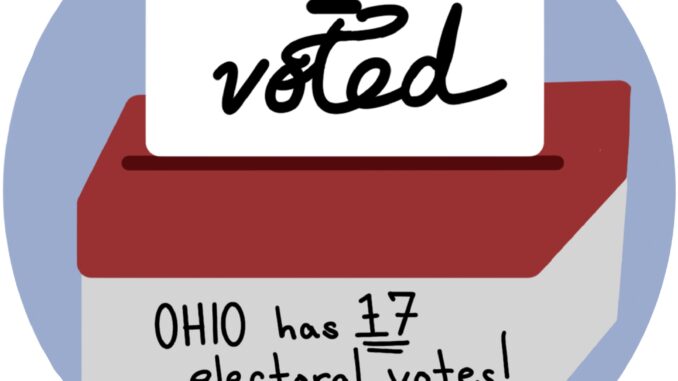
photo credit: Georgia Browning
To the buildup of the presidential election, media attention, polling, and money were focused on the seven key “swing states”: Nevada, Georgia, Michigan, North Carolina, Pennsylvania and Wisconsin. Why these states in particular? Because of the electoral college, our method of electing presidents every four years.
But over the years though, it’s worth asking if there is better ways to elect a president. Why does America have to focus on select areas of the country every four years? Why can’t it just look at what the whole country wants? Now may be the time to ditch the electoral college once and for all.
In the electoral college, a candidate needs 270 votes to win the presidency. In most states, the candidate who wins the plurality (meaning the most) of votes takes all of that state’s electoral votes. Exceptions to that rule exist in Maine and Nebraska, where electoral votes are given based on who wins the plurality in each congressional district rather than the whole state.
Each state is given electoral votes based on how many members represent their state in Congress. Every state contains two Senators and at least one U.S. Representative, giving the smallest states at least three electoral votes. Larger states contain more representatives in the House, and thus are awarded more electoral votes.
The District of Columbia, despite not being a state, is also given three electoral votes via the 23rd amendment. 100 Senators, 435 members in the House and three electoral votes from D.C make up a total of 538 electoral votes.
While the system is unique in how it elects a president, it also has flaws associated with it. ItsIt’s possible for a candidate to win the popular vote nationwide but fail to secure a majority of the electoral college, and thus lose the presidency entirely. This has occurred in five elections: 1824, 1876, 1888, 2000, and 2016, according to Britannica.
It’s also possible for the electoral college to tie 269-269, sending the election to Congress. If that scenario were to occur, each state delegation would get a single vote to pick the president, with 26 delegates needed to win the presidency, according to CNN. A tie in the electoral college has never occurred in the country’s history; if it were, outrage would result no matter how the results go.
In terms of representation in the electoral college, smaller states are drastically overrepresented compared to larger states. Because each state has a minimum of three electoral votes, smaller states have fewer people represented per electoral vote, while larger states have more. For example, Wyoming has 193,000 people represented per electoral vote, while California has 718,000 represented per electoral vote, according to The Guardian.
In a study conducted by Pew Research Center this year, 63 percent of Americans prefer to replace the electoral college with a popular vote, while only 35 percent prefer to keep the system. Among partisan lines, 80 percent of Democrats prefer to replace the system, while 53 percent of Republicans favor keeping the electoral college. Heightened support from Democrats for replacing the electoral college can be associated with two elections that occurred over the past 24 years.
Back in 2000, Florida narrowly went for George W. Bush by about 500 votes, allowing him to narrowly win the presidency by 271-266 electoral votes. Despite this, Al Gore ended up winning the popular vote nationwide by a margin of 0.5 percent. The recounts that resulted in the state lead to a month without a clear winner, leading to tension between both sides of the political aisle.
In a more recent example, the 2016 election had Hillary Clinton winning the popular vote by a margin of two points. Despite this, Donald Trump won the electoral college 304-227, causing her to lose the presidency. This contrast resulted in anger from Democrats and a heightened support for replacing the system among that group.
These two elections also explain heightened support from Republicans in keeping the system. While replacing the electoral college with a popular vote would remove drama that comes from a close result in a state or the popular vote differing from the electoral college vote, differing opinions on replacing the system could prevent a switch from occurring. It’s also possible that support for replacing the system flips if there is a future election where the Democratic candidate wins the electoral college while losing the popular vote.
Even if most Americans want to replace the system, it should be known that the electoral college is enshrined in the U.S. Constitution. That means if an effort to replace it took place, a constitutional amendment would need to be approved by two thirds of Congress or three fourths of the state legislatures in order to replace the system for good.
For right now at least, the electoral college is staying whether America likes it or not. Maybe in a future time, the system does get replaced with a popular vote, but for the time being, nothing will change with how the country elects its president every four years.


